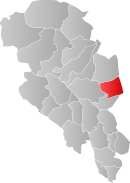Øyer
| Øyer kommune | |||
|---|---|---|---|
| Municipality | |||
|
|||
 Øyer within Oppland |
|||
| Coordinates: 61°15′55″N 10°24′48″E / 61.26528°N 10.41333°ECoordinates: 61°15′55″N 10°24′48″E / 61.26528°N 10.41333°E | |||
| Country | Norway | ||
| County | Oppland | ||
| District | Gudbrandsdal | ||
| Administrative centre | Tingberg | ||
| Government | |||
| • Mayor (2007) | Mari Botterud (H) | ||
| Area | |||
| • Total | 640 km2 (250 sq mi) | ||
| • Land | 616 km2 (238 sq mi) | ||
| Area rank | 176 in Norway | ||
| Population (2004) | |||
| • Total | 4,870 | ||
| • Rank | 196 in Norway | ||
| • Density | 8/km2 (20/sq mi) | ||
| • Change (10 years) | 3.9 % | ||
| Demonym(s) | Øyværing | ||
| Time zone | CET (UTC+1) | ||
| • Summer (DST) | CEST (UTC+2) | ||
| ISO 3166 code | NO-0521 | ||
| Official language form | Neutral | ||
| Website | www |
||
|
|
|||
Øyer is a municipality in Oppland county, Norway. It is part of the traditional region of Gudbrandsdal. The administrative centre of the municipality is the village of Tingberg.
The parish of Øier was established as a municipality on 1 January 1838 (see formannskapsdistrikt). It is one of very few municipalities in Norway with unchanged borders since that date.
The Old Norse form of the name was Øyja (accusative case and dative case) which comes from the word Øyi (nominative case). Two lakes in Norway had the name Øyi(r) in Norse times (now called Øymark and Øyeren), and these names are derived from the word øy which means "flat and fertile land along the edge of the water". This name is probably given to this area because the Lågen river widens out in the central part of the municipality and creates two river-lakes (called the Jemnefjorden and Gildbusfjorden). Øyi was probably the old name of one (or both) of these "fjords". Prior to 1918, the name was spelled "Øier".
The coat-of-arms is from modern times. They were granted on 29 April 1983. The arms show a silver-colored wooden ring, or hærder, on a green background. It was made of wood and was used to fasten a tree trunk to a rope in order to haul it over the land. Similar devices were used all over Norway, but this shape is typical for the area.
The Black Death reached Norway in the winter of 1349/50. Øyer was one of the parishes most severely impacted; estimates based on tax payments suggest that between 2/3 and 3/4 of all residents died. Many of the farms there became deserted farmss (øygarder), which remained vacant until the late 17th century. The parish of Tretten was merged into Øyer after the Black Death, because the decimated population of Tretten no longer could maintain their own priest.
...
Wikipedia


